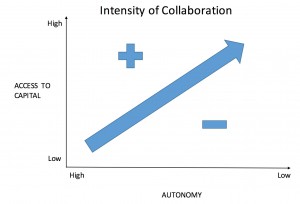Your organization does great things, but it may not be sustainable
The typical history of most nonprofit, charitable organizations in the United States begins with birth as a small, local agency started by a church or community leader who saw a social need and created a way to meet that need. Most often, these agencies survived because of volunteers and a few dedicated and underpaid staff. Funding came from modest fees and donations.
Today, the number of nonprofit organizations has increased exponentially, while the sources of revenue available to them from private and public sources has remained about the same. Competition for limited resources has become a significant challenge for many small to mid-sized nonprofits, and their future sustainability is in question because more agencies are seeking resources from the same public and private funding sources.
Nonprofit human service organizations are going to have to behave in a manner similar to that being observed in the health care industry. Previous competitors are now forming strategic partnerships in order to achieve the kinds of efficiencies demanded by the Affordable Care Act. The creativity being exhibited in these relationships is, quite frankly, amazing and should be studied for application by the social service sector. For example, community hospitals are forming joint ventures with equity investor groups, insurance companies, and university medical centers to infuse both capital and specialty services. In addition to improved quality and greater efficiencies, the benefit to investors is access to larger pools of patients.
What is at stake when considering a strategic partnership is organizational autonomy and control. But the price for maintaining total control is lack of capital. The reality is that access to capital is inversely proportional to the amount of control and autonomy. Giving up all control isn’t always necessary in every strategic partnership, but neither is staying broke.
There are many different forms of partnership along the continuum that runs from very high autonomy on the one end to very high integration on the other end. Most of these examples do not necessarily have to end up as complete mergers or acquisitions. They may include (from highest to lowest control) strategic partnerships such as:
- Information sharing

- Joint purchasing program
- Joint advocacy
- Networking
- Program coordination
- Fiscal sponsorship
- Administrative consolidation
- Joint service program
- Consortium or coalition
- Management services organization (MSO)
- Joint venture corporation
- Parent-subsidiary organization
- Merger
- Acquisition
I have been involved in one way or another with every one of these types of partnership arrangement. At the highest level of strategic restructuring, I worked as a merger integration project manager bringing together two social service organizations with a combined $140 million budget into a parent-subsidiary arrangement. Three years later, having exceeded expectations for synergies, a complete merger was effectuated. I have also been involved in the acquisition of smaller agencies, as well as trade association collaborative projects and international service agreements.
Leaders in the nonprofit social service sector recognize that collaborative arrangements between organizations are going to have to take place if many of these agencies are to continue their missions of service. Still, there are many reasons why there is reluctance on the part of agency leaders to explore such partnership/restructuring options. In my experience, much of the inertia comes from lack of knowledge on the part of agency CEOs. Part of the reason is also found in the very same lack of financial resources that limits their ability to grow and thrive. Hiring consultants to provide needed expertise takes money away from essential services. Still, when struggling organizations are running on negative days of operating capital, the only other option would seem to be bankruptcy. An old mentor of mine used to say, “You can’t cut your way to prosperity!” You have to find another way.
If your organization is struggling to survive and its sustainability is in serious doubt, perhaps you should consider possible partnerships with other organizations. The most likely prospects for such collaboration are those who compete with you for clients and funding. Yes, counterintuitive as it may seem, the very friends you should be seeking are your enemies in the market place. Chances are, they too are facing the same challenges you are. Making a list of competitors is a good starting place in determining possible alternative sustainable futures.
If you would like to explore this topic further, please give me a call. I would love to share my experience at no charge or obligation. Where our conversation might lead is for you to determine. All I know is that the future of nonprofit social service in this country is going to look very different ten years from now. I would like nothing more than to help you make sure your mission is still being carried out.
Let's Build Success That Lasts
